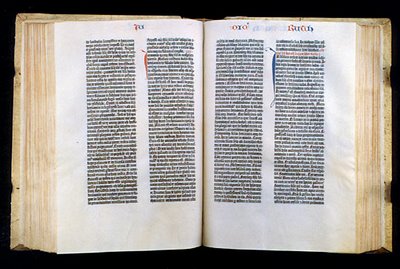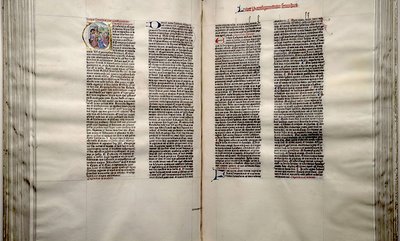A Book About The Book
I have not seen it myself. When he treated me to breakfast last week, my friend Wes, a master printer, told me about a blood-stained Bible he himself once handled.
It was a printed English Bible from the 1500s, a time when owning a Bible could result in persecution. Wes said the owner of this Bible had held it to his chest when a persecutor slashed him with a sword. The Bible reader’s blood soaked the pages, gluing some together.
Such was the price some paid to make God’s Word available to us today.
The thing that sparked this conversation between Wes and me was my current reading of Donald L. Brake’s new book, A Visual History Of The English Bible (Baker Books, Grand Rapids, Michigan. C. 2008). Dr. Blake is a founder of Multnomah Biblical Seminary in Portland, Oregon, and a past-president of Jerusalem University College in Israel. He owns an extensive collection of rare and ancient Bibles used to beautifully illustrate the text of his book.
I only own a meager shelf of modern-speech translations, hardly anything unusual except a two-volume, autographed Stringfellow New Testament—that obscure translation contains a single verse rendering sometimes cited by folks discussing the Trinity. My Bibles are just second-hand, not rare.
However, I’m proud of the fact that back in the late 1950s or early 1960s, I actually handled two of the rarest Bibles in the world.
Back then I worked as a peasant at the Library of Congress (along with 3,000 other government employees—see my March 8th posting, “Under The Fig Leaf”).
Anyhow, one day at the Library I noticed bugs in the two display cases containing a Gutenberg Bible and the Giant Bible of Mainz. I called this to the attention of library authorities and when they removed these precious documents to fumigate the display cases, they let me lift the Bibles and place them on a book cart.
So I got to actually touch the most valuable book in the world, the three-volume Guttenberg Bible, and the two-volume illuminated manuscript of the Giant Bible of Mainz.
Here’s a photo of the Gutenberg I touched:

The Gutenberg Bible was the first book ever to be printed on a press with movable type. It is printed on sheets of velum, and is considered to be the most valuable book in the world.
Here is a photo of the Giant Bible of Mainz:

This illuminated manuscript was hand-copied on velum by a scribe who recorded his progress by writing the specific date when he began and finished each particular section of the Bible. He began work on April 4, 1452, and finished on July 9, 1453.
Capital letters embellishing section headings are often gilded with gold leaf. The Library’s web site says that borders on many pages “are adorned with a branch, vine, and floral pattern that acts as a framework supporting artistic renderings of rabbits, hunters, stags, princesses, bears, and the like, all exquisitely designed and painted in bright primary colors”.
I once wrote a brief religious humor article for a newspaper about Bible transmission; if you’re interested it’s on-line here.
The main thing I remember about the Library of Congress’s exquisite Bibles is that each volume must weight more than a sack of cement!
Really heavy!
But memory of my brief touch with such historic Bibles whetted my interest, so I read Dr. Brake’s Visual History with enthusiasm.
He traces the transmission of God’s revelation to us from the original autographs in Hebrew or koine Greek through scroll and codex to illuminated manuscripts to the printed books we enjoy today.
Throughout his narrative Brake intersperses textboxes filled with information drawn from his own collection.
For instance, he pictures a copy of a Bible produced during the Civil War in Augusta, Georgia, by the Confederate States Bible Society; they printed this edition because yankees blockaded Southern ports cutting off our supply of Bibles.
Brake also pictures a Bible confiscated from the Confederate blockade-runner Minna, and resold for profit by the yankees.
And Brake shows how during the Revolutionary War, American minutemen once used pages of a Sauer Bible as gun wads to pack their muskets in order to fire at the British…
But, I’m getting off track—that’s all recent stuff—the heart of Brake’s book lies in his information about how the Bible came down to us from ancient times through the blood of martyrs—more valuable than the price of a Gutenberg.
“What Bible readers want today is a translation of God’s Word that is faithfully accurate to the original languages, artistically beautiful, genuinely dignified, easily readable, and crystal clear,” Brake said.
Another valuable feature of the book is that Dr. Brake provides several charts of variant readings—You’ve surely heard that because the Bible was copied by hand for so many years, then copyists’ mistakes must have crept into the text? Well, Dr. Brake details some of these variant readings in charts…
For instance:
Text.................... 1611 Version ...................1762 Version
Matt. 16:18……“Thou art Christ”…………”Thou art the Christ”
Luke 19:9……...”the son of Abraham”…….”a son of Abraham”
John 15:20……..”than the Lord”…………...”than his Lord”
Sort of shakes your faith in the reliability of Scripture, doesn’t it?
Dr. Brake supplies dozens of such comparisons between Bible versions in both English and Greek.
Most of these variant readings are just as startling as the ones in my excerpt, although Dr. Brake discusses more serious ones such as the Johann Comma in 1st John 5:7. Dr. Brake would say I oversimplify such textual matters, but I imagine that he’d agree that we can be confident that the Bible on your hotel nightstand reveals God and guides men aright.
I found the biggest drawback to this book to be the very thing that makes it strong—Dr. Brake’s expertise.
For instance, in places he assumes his readers’ familiarity with the multitude of abbreviations used to designate modern translations—KJV, ASV, RSV, NASB, RNEB, KJ21, ESV, HCSB—I have no idea what most of those cryptic initials stand for. I can never keep them straight.
Dr. Brake assumes more knowledge on the part of his readers than I have.
I have only lifted a Gutenberg Bible— I’m not able to read the thing.
The writing’s all squiggly.
Please, visit my website for more www.cowart.info and feel free to look over and buy one of my books www.bluefishbooks.info
posted by John Cowart @ 5:03 AM


3 Comments:
I'm a NIV girl myself, but this does sound interesting.
I was just here to see if I could take your wife "shopping"?
Great post. I found it when searching for "Multnomah Biblical Seminary"...one note for accuracy: The book you reference is written by Dr. Donald L. Brake - not "Blake".
Keep up the good work!
Our church owns a very ancient Bible. Must be more and a 100 years old. I must examin it more closely
Post a Comment
<< Home